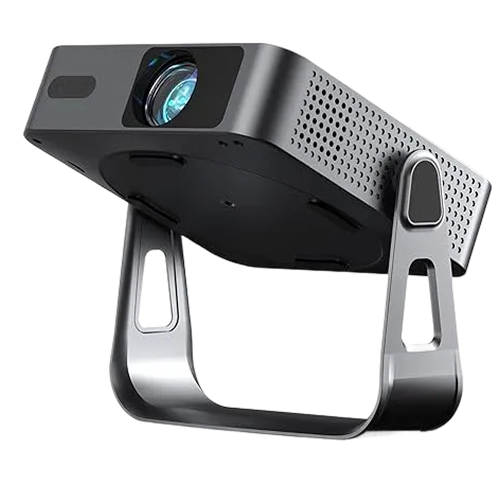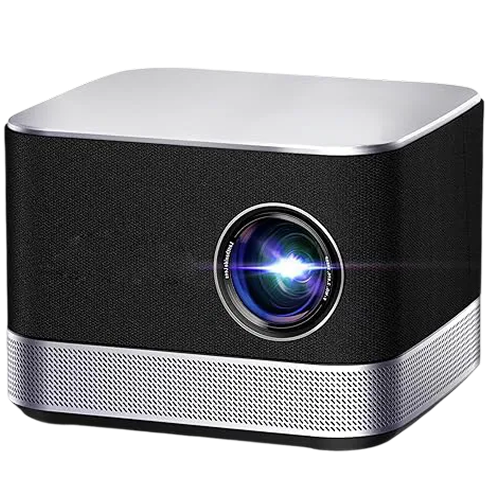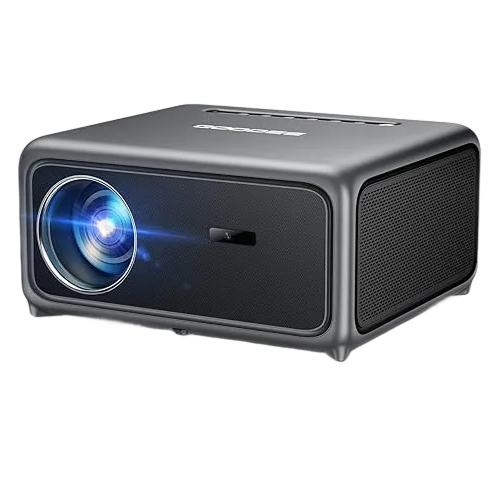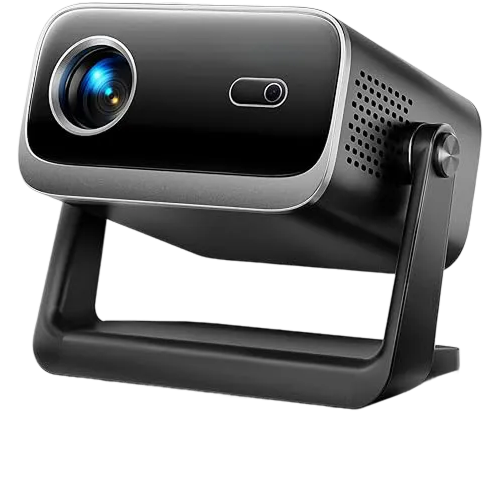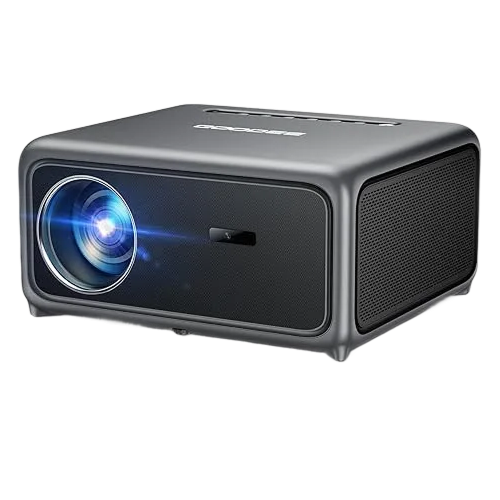4K projectors are a hot item right now, and it makes sense seeing as they’re the closest thing to a high-definition, big-screen television at a fraction of the cost. It’s a movie fan’s dream and something every serious gamer wants, and if you’re reading this, you’re probably curious too.
We’ve put together a comprehensive guide (long but worth it) to help you separate marketing fiction from what you’re actually getting when buying your projector. You’ll know for sure whether a 4K projector fits your needs, what a fair price looks like, which features to expect, and even where to sit for maximum impact.
Understanding 4K Resolution Types
Not all 4K projectors create images the same way, and the differences significantly affect both price and image quality. When shopping for a 4K projector, understanding these distinctions helps you avoid overpaying for features you don’t need or buying something that doesn’t deliver 4K quality.
Native 4K/True 4K
Native 4K projectors contain imaging chips with exactly 8.3 million physical pixels permanently arranged in a 3840×2160 or 4096×2160 grid. Each pixel on the chip corresponds directly to one pixel in your 4K content. This is like having 8.3 million tiny mirrors or LCD elements that each display one specific dot of color in your image.
How It Works
When you send a 4K signal to these projectors, they display every single pixel exactly where it belongs without any processing tricks. A native 4K projector showing a 3840×2160 image uses all 8.3 million pixels on its chip simultaneously to create that image.
What It Costs
Native 4K projectors start around $3,000 and extend well beyond $10,000 for premium home theater models. The imaging chips themselves are expensive to manufacture since creating perfect grids with 8.3 million tiny elements requires advanced fabrication technology. The optics are also more complex since they need to resolve that much detail without blurring.
Performance
These projectors deliver absolute reference quality sharpness. Every fine detail in 4K content appears exactly as intended with perfect clarity across the entire screen. Text looks razor-sharp even on massive 200+ inch screens. Architectural details, fabric textures, and distant objects all show the full resolution.
Pixel-Shifting 4K/4K UHD with XPR Technology
Pixel-shifting projectors use 1080p imaging chips containing 2.07 million pixels (1920×1080), but they create images that approximate 4K sharpness through a clever optical trick.
How It Works
The projector displays each frame twice in rapid succession. During the first display, the 1080p chip shows part of the image. Then, in a fraction of a millisecond, an actuator physically shifts the entire image diagonally by exactly half a pixel width. The chip displays the second part of the image in this shifted position. Your eye perceives both images as a single combined picture with approximately 4 million distinct pixel positions.
Some implementations shift twice (displaying the image four times per frame), creating even more perceived detail. The shifts happen so fast (hundreds of times per second) that your eye cannot detect the movement. Instead, you see what appears to be a higher resolution image.
What It Costs
Most 4K projectors under $2,500 use pixel-shifting technology. This makes sense financially since manufacturers can use less expensive 1080p chips and add a mechanical shifting mechanism rather than developing full native 4K chips. Current market examples range from $900 for entry-level models to $2,500 for premium pixel-shifting projectors with excellent contrast and color.
Performance
The image quality is genuinely impressive and substantially sharper than standard 1080p. From typical viewing distances of 10-12 feet, watching a 120-inch screen, pixel-shifting 4K looks excellent, and the difference from native 4K becomes difficult to spot. Fine details like text, architectural elements, and complex patterns show noticeably more clarity than 1080p.
Limitations
The improved resolution is perceptual rather than absolute, meaning that under very close viewing (under 6 feet) or on extremely large screens (over 150 inches), some viewers can detect that the sharpness doesn’t quite match native 4K. Again, fast-moving content sometimes reveals the shifting process as subtle shimmer in fine patterns, though this affects only a small percentage of viewers.
4K Enhancement/4K PRO-UHD/Upscaling
These projectors contain standard 1920×1080 Full HD imaging chips with 2.07 million pixels. They accept 4K input signals but do not use pixel-shifting hardware. Instead, they rely entirely on digital image processing to create the appearance of higher resolution.
How It Works
When a 4K signal enters the projector, the processor analyzes the image and uses algorithms to create artificial detail. The processing examines edges, textures, and patterns in the 4K source, then attempts to preserve or enhance these details when downscaling to the 1080p chip.
Frame interpolation adds intermediate frames between the original frames, creating smoother motion. Edge enhancement sharpens boundaries between objects, and detail enhancement attempts to preserve fine textures.
So, the projector is fundamentally displaying a 1920×1080 image, but the processing makes that image look sharper and more detailed than it would if you simply fed it standard 1080p content. But let me make the explanation even more relevant. You know how Instagram filters sharpen your photos? In reality, the photo doesn’t actually gain resolution, but processing makes it appear clearer.
What It Costs
This technology appears in projectors from established manufacturers in the $1,000-2,000 range.
Performance
The result looks sharper than standard 1080p but doesn’t approach true pixel-shifting or native 4K quality. Text shows improved clarity compared to standard 1080p. Architectural details and fine patterns benefit from the edge enhancement. However, the processing cannot create genuine detail that doesn’t exist in the physical pixel grid.
The upscaling works best with true 4K source content. When you feed these projectors 4K Blu-rays or 4K streaming, the processor has more information to work with and can create a convincingly sharp image. With 1080p source content, the enhancement is more limited since the processor cannot create detail from nothing.
Limitations
You’re still fundamentally watching a 1920×1080 image regardless of how good the processing is. The chip physically cannot display more than 2.07 million distinct pixels, and close viewing reveals this limitation.
Specifically, on screens above 120 inches, the lack of true 4K resolution becomes very obvious. And, in addition, fast motion can show processing artifacts where the enhancement algorithms struggle to keep up.
Some manufacturers label these clearly as “4K Enhancement” or “4K PRO-UHD,” making the distinction obvious. Others use more ambiguous marketing that might confuse buyers into thinking they’re getting pixel-shifting or native 4K.
How to Identify It
Look for specifications listing “4K Enhancement,” “4K PRO-UHD,” or “e-shift” technology combined with 1920×1080 native resolution. If the spec sheet shows 1920×1080 panels but claims 4K capability, it’s using upscaling rather than pixel-shifting or native 4K. Check whether the product description mentions “pixel-shifting,” “XPR,” or “native 4K.” If those terms are absent and you see “upscaling” or “enhancement,” you’re looking at processed 1080p.
4K Compatible or 4K Support / Not Actually 4K
These are budget projectors that accept 4K input signals but display them at 1080p, 720p, or even lower resolutions. These projectors have no capability to display 4K quality in any form.
How It Works
When you connect a 4K source like a streaming device or 4K Blu-ray player, these projectors recognize the 4K signal and accept it. The processor then immediately downscales the 4K input to match the projector’s native resolution, discarding most of the detail.
You’re watching standard definition or 1080p content that originated as 4K but has been compressed down to lower resolution before display. We can liken this to taking a high-resolution photograph, shrinking it to a small size, then printing it. The original had detail, but you’ve thrown away that detail before display.
What It Costs
If a projector costs under $600 and claims any form of 4K capability, it almost certainly falls into this category. Budget models selling for $150-500 commonly advertise “Supports 4K” or “4K Compatible” while actually displaying 1080p, 720p, or even 480p native resolution.
Performance
Image quality matches whatever the native resolution is. A projector with 1920×1080 native resolution that “supports 4K” will look identical to any other 1080p projector. The 4K compatibility provides zero image quality benefit. In fact, feeding it a 4K signal might introduce processing lag or artifacts compared to feeding it native resolution content.
Limitations
This is fundamentally misleading marketing designed to confuse buyers. The projector cannot display 4K quality in any meaningful way. It accepts a 4K signal only to immediately throw away three-quarters of the resolution before displaying anything.
How to identify It
Check the native resolution specification carefully. If it lists 1920×1080, 1280×720, or lower, the projector cannot display 4K, regardless of what marketing claims say about “4K support.” Extremely low prices (under $600 for “4K”) are, however, the biggest giveaway. As well, look for phrases like “supports 4K input” or “4K compatible” without any mention of “native 4K,” “pixel-shifting,” “4K UHD,” or “XPR technology.”
8K Resolution
8K projectors contain imaging chips with 33 million physical pixels arranged in a 7680×4320 grid. This provides four times the pixel count of 4K (which has 8.3 million pixels) and sixteen times the pixels of 1080p (which has 2.07 million pixels).
How It Works
8K is similar to native 4K, but with even more pixels. Each of the 33 million pixels displays independently, creating unprecedented detail density. The technology requires extremely advanced chips, optics, and processing power to handle the massive data throughput of 8K content.
What It Costs
8K projectors remain extremely rare and expensive, usually starting around $10,000 and extending to $30,000+ for commercial cinema installations. Only a handful of manufacturers produce 8K projectors at all.
Performance
The resolution is extraordinary, but realizing the benefit requires specific conditions. You need screens exceeding 200 inches viewed from under 6 feet to perceive the difference between 8K and 4K. At typical home theater viewing distances (10-15 feet) and screen sizes (100-150 inches), the human eye cannot resolve the additional detail that 8K provides over 4K.
Limitations
Almost no native 8K content exists outside of a few YouTube videos, technology demonstrations, and specialized film productions. Standard 4K streaming and 4K Blu-rays contain 8.3 million pixels, which means the 8K projector must upscale this content to fill its 33 million pixel display.
Additionally, the viewing conditions required to benefit from 8K create impractical home theater situations. Sitting 5 feet from a 200-inch screen forces you to move your head constantly to see the entire image, creating an overwhelming rather than immersive experience. Your field of vision can’t comfortably encompass that much screen from such a close distance. Even commercial movie theaters seat audiences at distances where 4K already delivers more resolution than human eyes can distinguish, making 8K unnecessary for typical cinema viewing.
The Reality
The technology solves a problem that doesn’t exist in real-world entertainment scenarios.
When to Consider 4K Resolution
Resolution only matters when you sit close enough or have a large enough screen for your eyes to perceive the extra detail. Buying a 4K projector for a 100-inch screen when sitting 15 feet away wastes money since you won’t see any difference from 1080p.
The Viewing Distance Formula
Your eyes can only resolve a certain amount of detail based on distance, following the rule: close viewing reveals more detail, while further viewing makes fine details disappear.
For 4K content, you need to sit within approximately 1.6 times the screen height to see the full resolution benefit. For a 100-inch diagonal 16:9 screen (which is 49 inches tall), that means sitting within about 6.5 feet to perceive the complete 4K advantage. Between 6.5-12 feet, you’ll still notice improvement over 1080p, but won’t see the full resolution benefit. Beyond 13 feet, the difference becomes minimal.
For perspective, with a 1080p projector, you need to sit within 3 times the screen height to see the full resolution. Therefore, for the same 100-inch screen, 1080p looks sharp up to 12 feet away.
What this means is that 4K is valuable when you either have very large screens or sit closer than typical home theater viewing distances.
Screen Size Considerations
100 inches or smaller
At typical viewing distances of 10-12 feet, 1080p provides excellent image quality. 4K offers minimal visible improvement unless you sit unusually close. Save money and get a quality 1080p projector with excellent contrast and brightness rather than a mediocre 4K model.
100-120 inches
This is the transition zone where 4K starts showing benefits at 8-12 foot viewing distances. Pixel-shifting 4K makes sense here if your budget allows. Text and fine details appear noticeably sharper compared to 1080p.
120-150 inches
4K resolution clearly improves image quality at normal viewing distances of 10-14 feet. The extra sharpness becomes obvious during scenes with text, architectural details, or complex patterns. Pixel-shifting 4K delivers excellent results.
150 inches and larger
4K becomes essential since 1080p starts looking soft and pixelated. Native 4K provides the best results on very large screens, though pixel-shifting still performs well. At this screen size, you’re definitely seeing the resolution difference from any reasonable seating position.
Other Considerations for Resolution
Eyesight matters in these calculations. Viewers with better than 20/20 vision can sit slightly farther and still resolve 4K detail, while those with corrected or slightly impaired vision might need to sit closer. Most people fall somewhere in the middle, making the 1.6× screen height guideline a reliable starting point.
Source content quality also affects what you see on screen. A well-mastered 1080p Blu-ray often looks better than poorly compressed 4K streaming. Good upscaling helps mediocre sources, but excellent native content showcases your projector’s true capabilities regardless of resolution.
Brightness Requirements for 4K and HDR
4K content frequently includes HDR (High Dynamic Range), which requires significantly more brightness than standard content to display properly. HDR contains information about brightness levels from deep blacks to brilliant highlights. Your projector needs sufficient light output to display those bright highlights convincingly while maintaining detail in darker areas.
Most 4K projectors need at least 1,500 ANSI lumens (the standardized measurement) to display HDR acceptably in dark rooms with 100-120 inch screens. For larger screens or rooms with some ambient light, 2,500+ lumens becomes necessary.
Brightness and Screen Size Interaction
Brightness requirements scale dramatically with screen size. Each time you double the screen diagonal, you need roughly 4x the brightness to maintain the same image quality.
A 4K projector with 2,000 lumens creates a bright, vibrant HDR image on a 100-inch screen in a dark room. That same projector on a 200-inch screen produces a dim, barely visible image since the light spreads across four times the area.

For screens above 150 inches, 4,000+ lumens becomes necessary to maintain image brightness and HDR impact.
Understanding HDR Tone Mapping
Projectors can’t match the brightness levels in HDR content, so they use tone mapping to compress the brightness range into what they can display.
Tone mapping is the process of taking HDR content mastered at 1,000-4,000 nits brightness and remapping it to fit what your projector can produce (typically 100-300 nits), while trying to preserve the visual relationships between bright and dark areas.
Good tone mapping preserves detail and maintains the visual impact of HDR, while bad tone mapping produces dim, crushed images that look worse than SDR content.
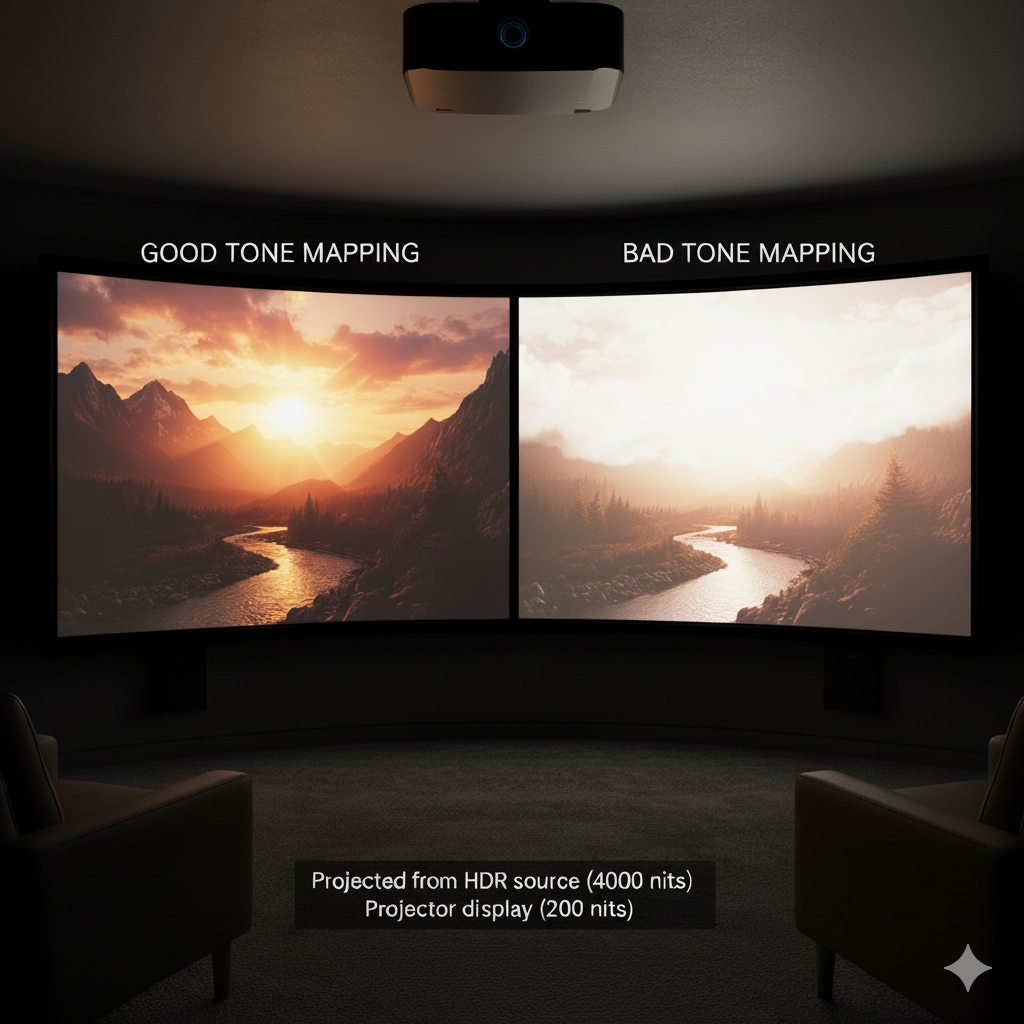
Some 4K projectors offer HDR10, which uses static tone mapping applied to entire movies. Better models support HDR10+ or Dolby Vision, which adjust tone mapping scene by scene or even frame by frame for optimal results.
When HDR isn’t working properly, the brightness drops so low the image becomes almost unwatchable. This mostly happens when the projector lacks sufficient lumens for your screen size or when tone mapping settings need adjustment.
Contrast and Color for 4K Content
Resolution means nothing if contrast and color reproduction are poor. 4K content showcases incredible detail, but you need high contrast to see detail in shadow areas and wide color gamut to display rich colors properly.
Contrast Ratio Importance
Contrast ratio measures the difference between the darkest blacks and brightest whites a projector can produce. A projector with 2,000:1 contrast shows a black level that’s 2,000 times darker than its white level. Higher numbers mean deeper blacks and more visible detail in dark scenes.
Native contrast is what the projector can do with fixed settings. This is the real number that matters. Many manufacturers quote dynamic contrast (like 500,000:1), which uses an iris to adjust brightness between scenes. These numbers aren’t comparable to native measurements since they represent sequential changes, not what’s visible simultaneously.
Display technology affects contrast variedly:
- DLP projectors deliver 1,000-3,000:1 native contrast
- 3LCD projectors achieve 2,000-5,000:1
- LCoS technology reaches 10,000:1+ in premium models

[Alt Tag] Side-by-side comparison of projector contrast ratios
A 4K projector with 2,000:1 contrast produces grays instead of blacks, while one with 10,000:1 produces true blacks with visible shadow detail. The difference is immediately obvious in space scenes or dark interiors.
Target at least 3,000:1 native contrast for acceptable viewing. Dedicated home theaters need 10,000:1+ to see proper shadow detail, while premium models reach 15,000-40,000:1 with the deepest blacks available.
Color Gamut Coverage
Color gamut defines the range of colors a projector can display. Rec.709 is the standard TV color space covering about 35% of visible colors, while DCI-P3 is the cinema color space covering about 45% with richer reds and greens.

[Alt Tag] The three triangle outlines compare Rec.709, DCI-P3, and Rec.2020 coverage in the same space.
Budget 4K projectors achieve 80-95% Rec.709, whereas mid-range models hit 95-105% Rec.709 and start reaching into DCI-P3 territory. Premium models achieve 90-110% DCI-P3, producing visibly richer colors that match what filmmakers intended.
Light source technology is also an important consideration:
- Traditional lamps struggle to exceed Rec.709
- Single laser projectors improve but still fall short of full DCI-P3 coverage
- Triple laser projectors achieve 99-110% DCI-P3. However, these start around $1,200, but they deliver noticeably richer colors than LED or single laser models.
Prioritize at least 3,000:1 native contrast and 95% or better Rec.709 color coverage as minimums. BUT…if you have a dedicated home theater, you need 10,000:1 or higher contrast paired with 90% or better DCI-P3 coverage to show 4K content as intended.
Display Technology for 4K Projectors
The imaging technology inside your projector determines how it creates the picture, and each technology has distinct characteristics that affect image quality at 4K resolution.
DLP (Digital Light Processing)
DLP uses millions of tiny mirrors that tilt to reflect light toward or away from the screen, with each mirror representing one pixel that tilts thousands of times per second to create different brightness levels. A spinning color wheel in front of the light source cycles through red, green, and blue to create colors, and your eye blends these rapid flashes into a full-color image.
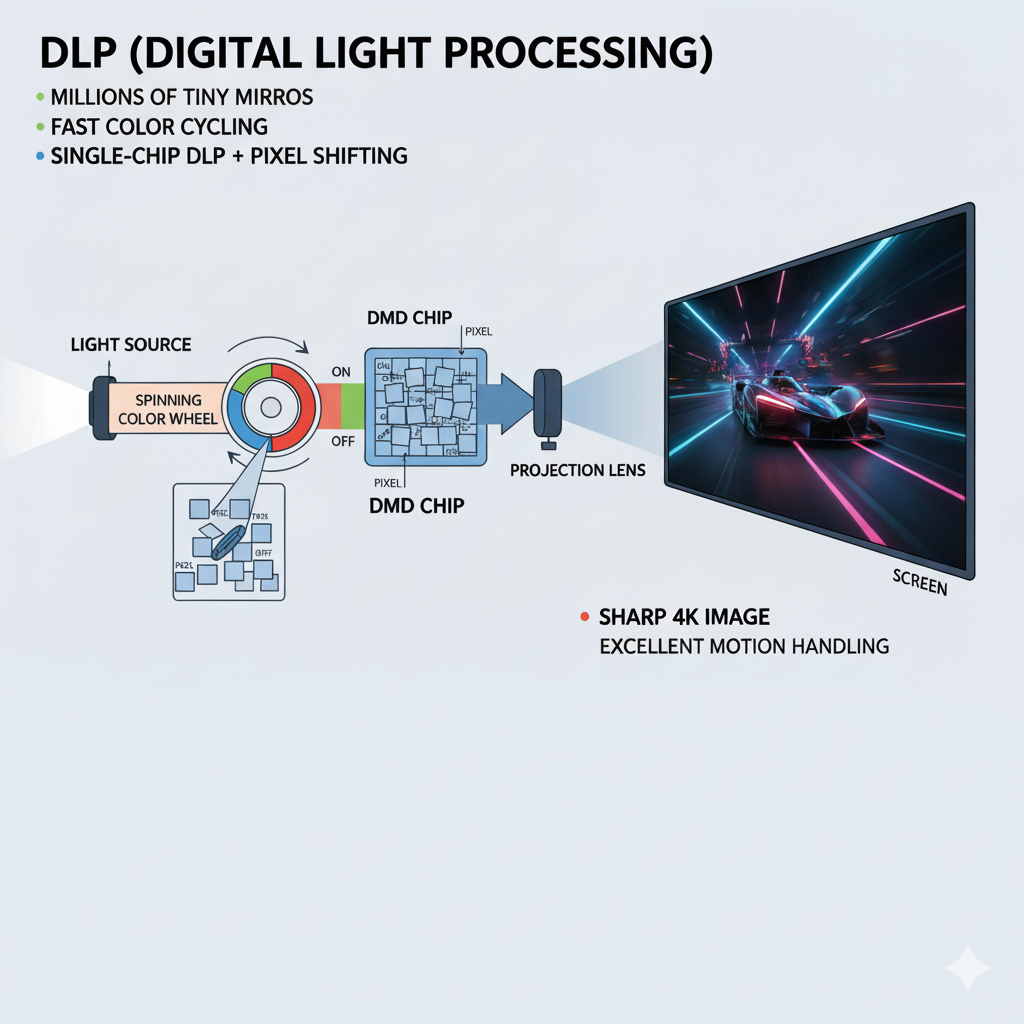
Most 4K projectors under $2,500 use single-chip DLP with pixel-shifting, which produces sharp images with excellent motion handling that makes gaming feel responsive with no motion blur or ghosting in fast-paced scenes. Contrast typically ranges from 2,000:1 to 10,000:1 depending on the model.
The drawback is the rainbow effect, where some people see brief flashes of red, green, and blue separation during eye movements or in high-contrast scenes. About 10-20% of viewers are sensitive to this, though newer DLP projectors minimize the issue through faster color wheels that cycle colors more rapidly than your eye can detect.
3LCD (Three Liquid Crystal Display)
3LCD uses three separate LCD panels for red, green, and blue that work simultaneously. The projector splits white light into three color beams, passes each through its own LCD panel to create the image for that color, then recombines all three beams into a single full-color image. Since all three colors display at once rather than sequentially, there’s no color wheel and no rainbow effect.
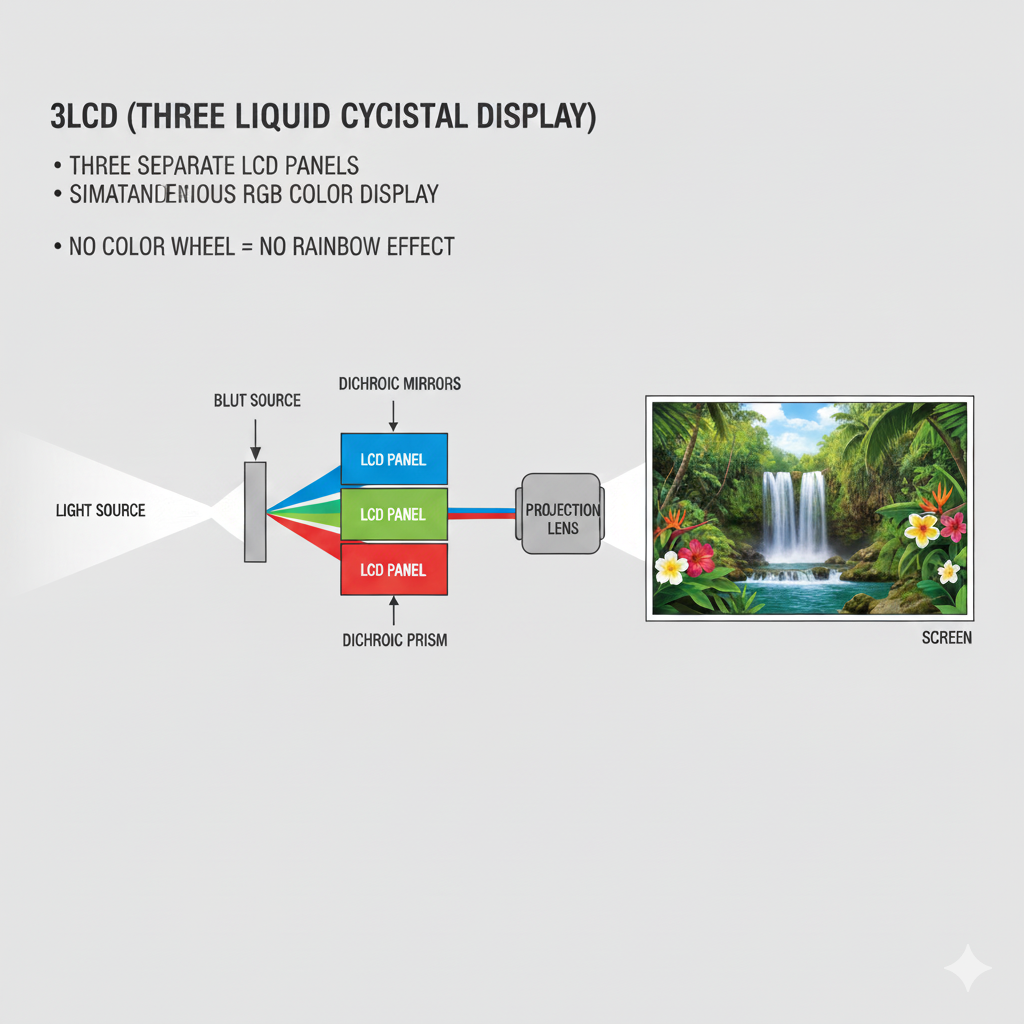
3LCD typically produces better color accuracy than DLP and achieves higher brightness at similar price points, while models using RGB liquid crystal shutters maintain excellent color reproduction. Native contrast typically ranges from 2,000:1 to 5,000:1, though quality models can reach 35,000:1 to 40,000:1 for solid black levels.
For 4K viewing, any convergence errors become more visible since the higher resolution reveals minor misalignments between the three panels, though this affects only a small percentage of projectors and usually appears as slight color fringing at sharp edges.
LCoS (Liquid Crystal on Silicon)
LCoS uses liquid crystals applied directly to a reflective silicon chip rather than passing light through transparent panels, with the liquid crystals sitting on top of the silicon backing that reflects light back through them. This creates a denser pixel structure with virtually no space between pixels, producing smoother images. Like 3LCD, it uses three separate chips for red, green, and blue, and it’s branded as SXRD by Sony or D-ILA by JVC.
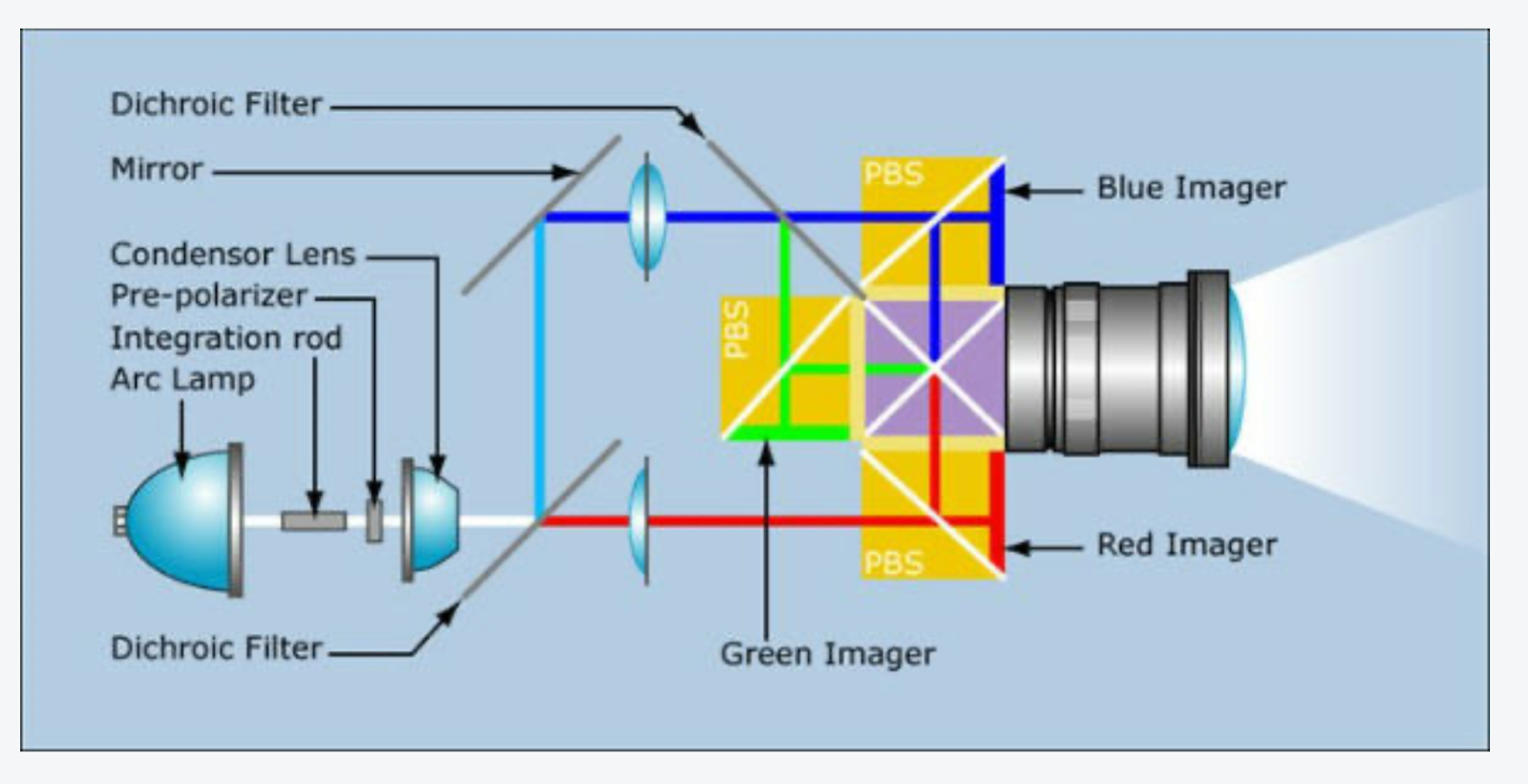
Image Source: Projector’s Screen
Premium 4K projectors above $3,000 often use LCoS technology, which delivers exceptional contrast ranging from 15,000:1 to 40,000:1 while eliminating rainbow effect and producing extremely smooth images without visible pixel structure.
Placement and Installation for 4K
Getting your 4K projector properly positioned is very important. Improper placement forces you to use digital corrections that throw away pixels and defeat the purpose of buying 4K in the first place.
Throw Distance and Throw Ratio
Throw ratio determines how far from the screen your projector needs to sit to create a specific image size. To calculate the throw distance, we use the formula:
Throw Distance = Throw Ratio × Screen Width
So, measure your room, determine where you can mount the projector, and calculate the distance to your wall so you know which throw ratios will actually work in your space. Knowing this helps you match projectors to your room’s actual dimensions.
Ultra Short Throw (0.25:1 or less)
UST projectors sit inches from the screen, usually creating 80-100 inch images from about 4-20 inches away. UST 4K projectors work well in small rooms where ceiling mounting isn’t practical. Note that they’re also pricey, starting around $2,500 and require specialized screens designed for their extreme projection angles.
Short Throw (0.4:1 to 1.0:1)
These projectors create 100-inch images from roughly 4-9 feet away. The closer placement means you can walk in front without blocking the image, which makes them popular for living rooms where people move around during viewing.
Standard Throw (1.2:1 to 2.0:1)
This is the most common range, where a standard projector with a 1.3:1 throw ratio can create a 100-inch image from about 11.2 feet. Models featuring 1.62 x optical zoom add flexibility, letting you adjust from 40 inches at 7.7 ft to larger sizes as you move back. This is useful when your preferred mounting spot doesn’t line up with the exact throw distance.
Long Throw (2.0:1+)
Long throw projectors suit large venues or situations where you need to create massive screens exceeding 200 inches. These require positioning the projector 20+ feet from the screen, making them impractical for typical home theaters but ideal for auditoriums, large conference rooms, or outdoor cinema setups.
Optical Zoom and Lens Shift
Optical zoom lets you adjust image size without moving the projector. A 1.5x or 1.6x zoom ratio provides significant flexibility, while projectors with fixed zoom require exact positioning.
Lens shift, on the other hand, physically moves the lens assembly to reposition the image without digital corrections, and vertical lens shift allows you to project up or down without angling the projector.
Premium 4K projectors above $2,000 typically include both optical zoom and lens shift, while budget models often skip these features entirely and use fixed lenses that require positioning at one exact distance.
Digital Keystone Correction (Use Sparingly)
When you mount a projector at an angle to the screen, the image becomes trapezoidal. Keystone correction digitally squashes the image back into a rectangle, but this crops pixels and reduces effective resolution. Heavy keystone correction can make your 4K projector display effective 3K or even 2K resolution after the digital transformation.
For 4K projectors, minimize or avoid keystone correction entirely. Position the projector correctly using throw distance calculations, optical zoom, and lens shift. Accept minor misalignment of 1-2 inches at screen edges since this becomes invisible during viewing.
Modern projectors include auto keystone that detects angles and corrects automatically. This is convenient but still degrades the image the same way manual keystone does. Notably, some premium models offer optical keystone correction, which uses lens adjustments rather than digital processing to maintain image quality.
Screens for 4K Projectors
Projecting onto painted walls works for casual viewing with budget projectors. For 4K projectors above $800, a dedicated screen significantly improves the image since 4K resolution shows wall texture, paint inconsistencies, and surface irregularities that 1080p hides.
And as screens go above 120 inches, wall texture becomes increasingly obvious. Therefore, you need a dedicated screen to eliminate this issue entirely and to provide better color accuracy, while also improving brightness through directional gain. Learn more about projector screens in our guide.
Audio Solutions for 4K Setups
Built-in projector speakers range from 10W to 30W and rarely satisfy home theater standards, which creates a challenge when your projector is ceiling-mounted 15 feet behind your seating position and you need to get sound to speakers near the screen in front.
HDMI eARC/ARC is the best solution since most current 4K projectors include enhanced Audio Return Channel support for lossless transmission of Dolby Atmos and DTS:X, though you’ll need to run cables across your ceiling or along walls.
Bluetooth Audio eliminates cables but only supports stereo rather than surround sound, making it suitable for casual viewing. Direct Source Connection, on the other hand, works by connecting devices directly to your AV receiver and sending only video to the projector, though this bypasses the projector’s built-in smart features.
For dedicated home theaters, plan cable runs during installation or accept visible cables for proper surround sound, since wireless HDMI adapters remain unreliable for 4K transmission.
Operating and Environmental Factors
Here are a few other factors to consider:
Cooling and Fan Noise
4K projectors generate significant heat from their light sources and processing, which requires active cooling fans that produce noise measured in decibels (dB).
Current 4K projectors fall into these noise ranges:
- Under 27 dB: Premium models achieve whisper-quiet operation at 24-26 dB in normal mode
- 27-30 dB: Most quality 4K projectors operate in this range, which is noticeable in silent rooms but not distracting during viewing
- 31-35 dB: Moderate noise that’s acceptable for gaming or rooms with background noise
- 36+ dB: Loud fan noise that competes with dialogue and soundtracks
Eco modes reduce fan noise significantly, with some UST models dropping from 36 dB in normal mode to 23 dB in eco mode. For dark room viewing where you don’t need maximum brightness, eco mode provides quieter operation at the cost of 20-30% brightness reduction.
Also note that temperature affects fan performance. Most 4K projectors specify operating temperature ranges of 32-95°F, which works fine for climate-controlled indoor spaces but may cause fan speed increases or thermal shutdowns in hot rooms without air conditioning.
Warranty and Support
For 4K projectors in the $1,500-5,000 range, look for at least 3-year warranties as anything under 2 years signals potential reliability concerns. Premium models offering 5-year warranties show strong manufacturer confidence. And for lamp-based projectors, verify whether the warranty covers the lamp separately since some offer extended lamp coverage beyond the standard projector warranty.
Connectivity and Features for 4K
4K content delivery requires specific connections and features that may not exist on older or budget projectors.
HDMI Specifications
HDMI version determines how much data the connection can handle, which affects whether you can display 4K at higher refresh rates or access advanced features like variable refresh rate for gaming.
HDMI 2.0 handles 4K at 60Hz, which works fine for movies and most streaming content. Nearly all 4K projectors include at least one HDMI 2.0 port, with many offering two or three HDMI inputs.
HDMI 2.1 enables 4K at 120Hz, which is important for modern gaming consoles like PlayStation 5 and Xbox Series X. However, gaming at native 4K 120Hz is rare. Most gaming projectors achieve 240Hz refresh rates at 1080p (Full HD) rather than at 4K resolution, providing extremely smooth motion for competitive gaming at lower resolutions.
Smart Features and Streaming
Many 4K projectors include built-in smart platforms like Android TV, Google TV, or proprietary systems. Netflix certification is important here since Netflix restricts its app to certified devices, so verify your projector includes verified Netflix support before buying.
Google TV and Android TV offer the best experience with wide app support and regular updates, and most current projectors include WiFi (often WiFi 6) and Bluetooth (5.0-5.2) for wireless connectivity.
What 4K Projector Should You Buy?
Content Considerations and Demo Material
4K resolution shines with nature documentaries, architectural videos, and modern gaming where fine detail really matters. However, older films shot on grainy stock and fast-action scenes show minimal improvement since motion blur and source limitations mask the resolution advantage.
When testing your new projector, choose content that showcases these strengths. Planet Earth II and Blue Planet II demonstrate resolution and color accuracy. Interstellar and Gravity test black levels with their stark space scenes. Desert sequences reveal HDR capabilities through bright sun and deep shadows, while cityscape footage shows whether your projector can resolve fine architectural details.
How to Verify What You’re Getting
To avoid the misleading terms used by manufacturers in advertising, here’s how to verify true 4K capability when shopping for projectors:
Check the specifications section for native resolution. Look for:
- “Native 4K” or “3840×2160 native resolution” means true 4K
- “4K UHD with pixel-shifting” or “XPR technology” means pixel-shifting 4K
- “1920×1080 with 4K enhancement” means upscaling only
- “Supports 4K” without other qualifiers likely means resolution conversion only
Price can also be your starting point:
- Under $800: Likely 1080p with 4K input support only
- $800-2,500: Likely pixel-shifting 4K
- $3,000-10,000: Could be native 4K
- Over $10,000: Likely native 4K with premium features


